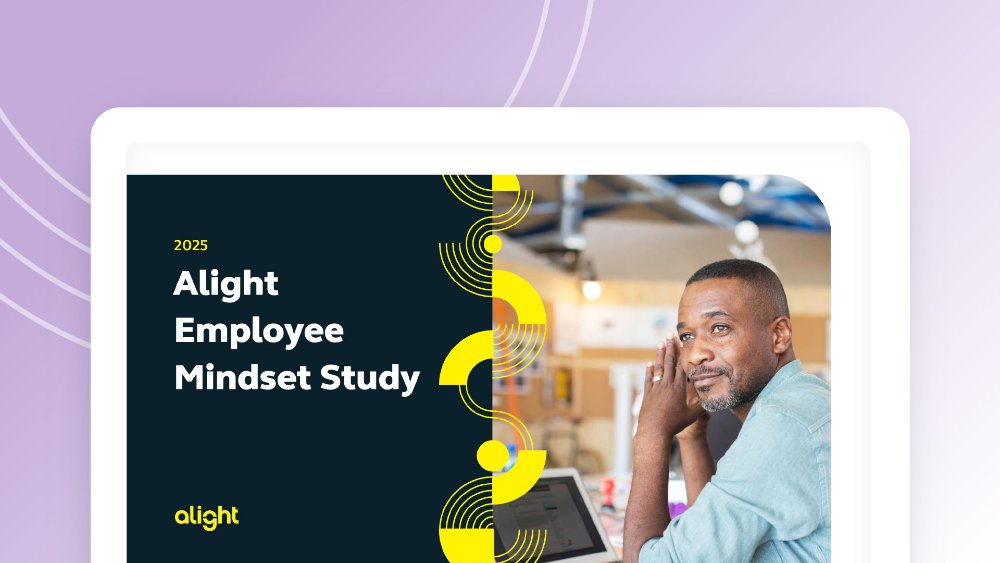In 1965, the songwriting team of John Lennon and Paul McCartney created one of the greatest hits of the British Invasion. Written for The Beatles’ second feature film, the title song, “Help!” featured the unmistakable vocals of Lennon pleading, “Help! I need somebody. Help! Not just anybody.” Fast-forward six decades, and today’s workforce is echoing the same refrain — not because they’re dealing with the bright spotlight of Beatlemania, but because they’re looking for help with their benefits.
Insights from Alight’s 2025 Employee Wellbeing Mindset Study show that when employees see a laundry list of programs, they are not so self-assured. They want someone to hold their hand and point them toward the benefits that will help them take a sad song and make it better when it comes to their health, wealth and wellbeing.
Do you want to know a secret? Here’s how employers can step up and deliver a benefits experience that combines clarity, customization and compassion:

Benefits are here, there and everywhere, but usage lags
Over the last few years, employers have launched a benefits revolution, expanding their menus dramatically. Beyond core offerings like health insurance, retirement plans and paid time off, 85% of workers now have access to at least one wellbeing program — up from 78% just three years ago. From fertility planning and diabetes prevention to healthy aging initiatives and digital coaching, organizations cover nearly every facet of physical, mental and financial health. That means a lot.
Yet participation rates tell a different story. On average, only about one-third of employees use each program available to them. However, when employees utilize them, almost 85% say they’re valuable. Getting more people to actually take advantage of them remains the real hurdle.
“When I was younger, so much younger than today”
Younger workers are much more likely to say they want help from their employer than their older counterparts. For example, 74% of Gen Z and 73% of Millennials say having personalized support for navigating the health system is valuable vs. only 58% of Gen Xers and 49% of Boomers.
Moving from a magical mystery tour of options to a supportive path forward
Why the disconnect? Workers aren’t just scanning for “free stuff.” They want counsel. They want to know which programs align with their personal goals, whether that’s tackling student loan debt, building an emergency savings cushion or losing those last stubborn 10 pounds. They crave simple, trustworthy recommendations at the time that is most important.
And because almost nine in ten (87%) employees say it’s important to have a one-stop shop for all health, wealth and wellbeing resources, workers want access to a single place where all the recommendations come together and are easy to navigate any time at all.
Here are some of the top requests:
Financial health
- 56% would like guidance on choosing between different retirement savings vehicles and access to professionals who can tailor investment portfolios.
- 51% want their employer to help reduce or refinance student loans.
- 50% seek assistance with establishing an emergency fund.
Work-life balance and stress management
- 40% would like help deciding how and when to take time off.
- 39% seek tips for balancing work and life.
- 35% crave a program to help them manage their stress.
Physical and mental health
- 31% want tools to monitor physical health.
- 38% would like support managing mental health conditions.
- 27% crave a program to help improve sleep habits.

Getting better: action items for employers
You don’t need to hire Ringo Starr (or Pete Best) to drum up benefits enthusiasm. Instead, consider these five tangible steps:
- Use a technology-enabled benefits portal
Have a digital platform where employees can browse, compare and enroll in different wellbeing benefits. Make the portal optimized for mobile and desktop to reach workers wherever they are. Integrate decision-support tools (such as a guided questionnaire or AI-powered advisor) that highlight relevant programs based on each worker’s life stage, health metrics and financial goals. Result: 87% of employees will feel their benefits are more accessible. - Offer personalized, high-tech recommendations
Tomorrow never knows what life may bring, so it’s important to leverage data and AI to provide tailored suggestions. Prompt a younger worker to redirect more payroll deductions into an HSA if they have minimal healthcare expenses today but anticipate higher costs in the future, for example. Or for employees with student loans, flag refinancing partners that provide competitive rates — and walk them through the process. Personalized nudges can raise program usage. - Provide high-touch expert support
For all the convenience of technology, sometimes employees want to talk to a real human. This may be to translate medical jargon, map out a savings plan or tend to any number of needs. Give employees the choice to chat one-on-one with professionals who are well-versed in these areas and can provide unconflicted advice to ensure their best interests are at the heart of every little — or big — thing. - Shine a spotlight on high-value programs
Even with guidance, some benefits deliver outsized returns. Here’s how a few top wellness offerings break down:Program
Used in last year, when offered
Value, among people who used
Healthy aging
12%
80%
Heart health
14%
87%
Getting paid more frequently
12%
83%
Nutrition, healthy eating and/or weight management classes or programs
20%
85%
Personalized health management
17%
82%
Access to low-interest short-term loans
12%
81%
Paid Time Off exchange
19%
88%
When highlighted effectively, these programs can become benefits that boost overall engagement and generate measurable ROI in the form of reduced absenteeism, fewer safety incidents and higher retention rates. - Measure, iterate and celebrate
Over their brief seven years of recording, The Beatles evolved in an unprecedented fashion — from “She Loves You” to “A Day in the Life” to “The Long and Winding Road.” So, too, must benefits offerings evolve. The employer’s role is simple: Track enrollment, utilization and employee feedback, then remix the approach. Celebrate wins and spotlight new offerings that come from employee input.
The Beatles’ “Help!” wasn’t just a catchy pop song. As Lennon revealed years later, it was a call for connection from an overwhelmed young man caught up in a whirlwind. Today’s employees are feeling much the same — without the worldwide fame and screaming girls.
They are easily overwhelmed by seemingly endless text packed into a dense benefits brochure. What they want — and need — is for their employer to provide empathy, expertise and a tailored experience that makes benefits feel as intuitive as their favorite song. And in the end, employees aren’t just helped, they are empowered to perform at their best.

Health Benefits
Integrated Employee Health Solutions
Now your employees can engage with their health benefits in an impactful way. ROI guaranteed.


